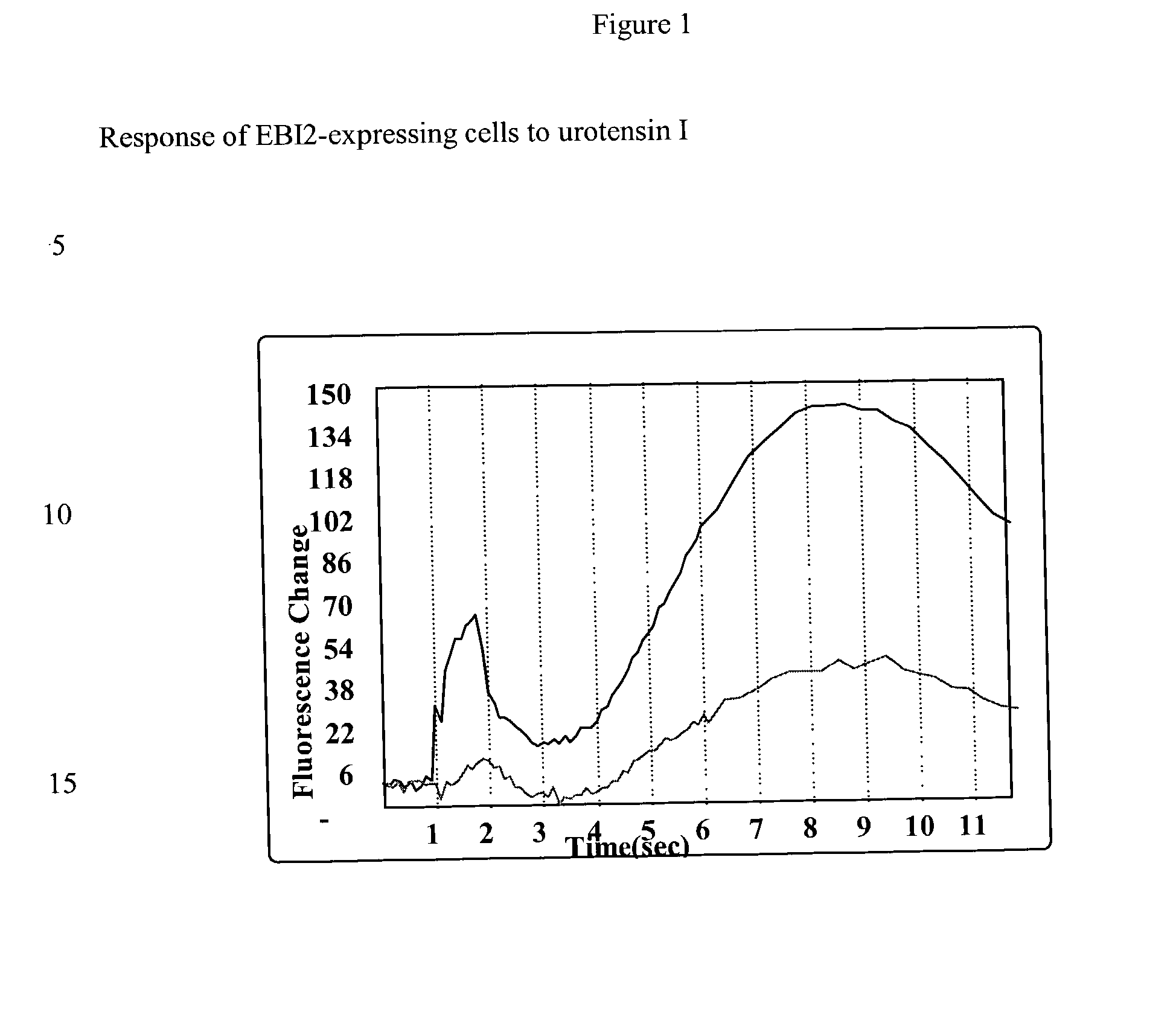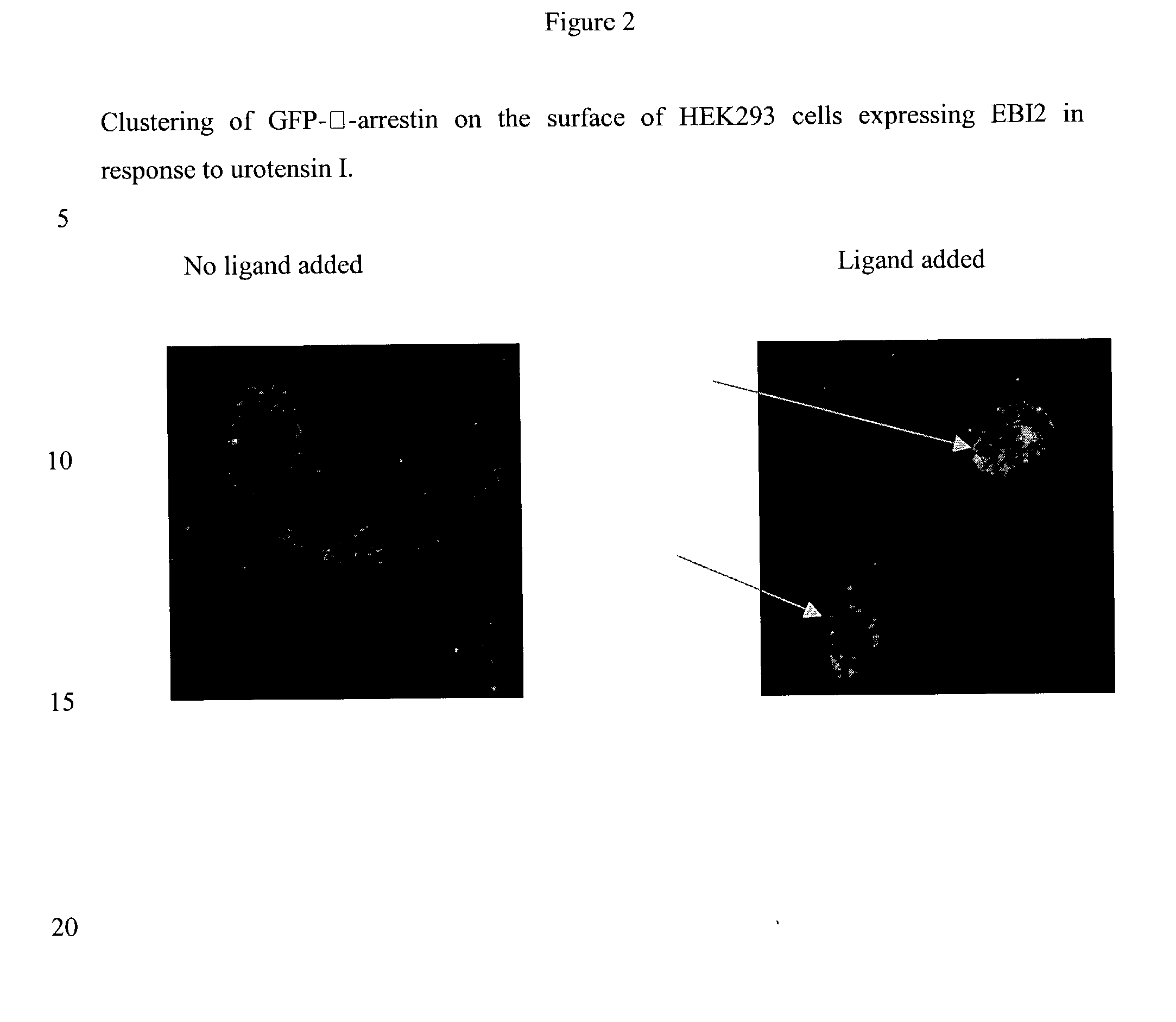Neuropeptide receptor and uses thereof
a peptide receptor and neuropeptide technology, applied in the field of neuropeptide receptors, can solve the problems of difficult identification of the ligand to which such an orphan receptor may respond, difficult measurement of intracellular effects, and inability to bind an agonist to this receptor,
- Summary
- Abstract
- Description
- Claims
- Application Information
AI Technical Summary
Benefits of technology
Problems solved by technology
Method used
Image
Examples
example 1
Bioinformatics Analysis of the EBI2 Sequence
[0139] (a) Blast against protein databases
[0140] The sequence of EBI2 was searched against Swissprot using the BLAST algorithm (Basic Local Alignment Search Tool (Altschul S F (1993) J. Mol. Evol. 36, 290-300; Altschul, S F et al (1990) J. Mol. Biol. 215, 403-410; Altschul S F et al (1997) Nucl. Acids Res. 25, 3389-3402)) to identify the closest protein match. In this case the top hit was to: P32250 Chicken P2Y5 receptor.
[0141] These results confirm that EBI2 is a member of the GPCR family.
[0142] (b) BLAST Search Against a Non-Redundant Human GPCR Database
[0143] The EBI2 sequence was searched against a non-redundant human GPCR database comprising mainly sequences from Genbank and the Derwent Geneseq database (containing sequences from patent applications / patents) in order to identify the class of agonist for this receptor. The top ten hits are shown below; these hits all have similar probability scores making the order of the hits arbitrar...
example 2
Tissue Distribution of EBI2
[0151] (1) EBI2 mRNA
[0152] (a) A gene expression microarray, which, amongst 6800 human cDNAs, also contains EBI2, was used in a number of experiments, hybridising labelled probes derived from mRNA or total RNA from a variety of tissues and cells. Significant expression of this sequence was only found in the haemic / immune system and lung.
[0153] (b) By searching expressed sequence tag (EST) databases, EBI2 cDNA clones were identified in libraries from a wide variety of differently treated peripheral blood mononuclear cells, such as lymphocytes, eosinophils, macrophages, monocytes, dendritic cells, leukocytes, as well as lymph node, tonsil, and spleen. It was also found in various lung cDNA libraries. ESTs from this cDNA sequence were also found in various libraries from other tissues, albeit at much lower frequency.
[0154] (c) PCR using cDNA from various tissues is a more sensitive method to determine in which tissues the EBI2 transcript can be found. PCR was...
example 3
Cloning and Transient Expression of EBI2 in Mammalian Cell Lines
[0174] The cDNA encoding EBI2 was obtained by polymerase chain reaction (PCR) of cDNA from peripheral blood leukocytes (PBL; Clontech). The PCR primers were designed around the putative ATG start codon and the stop codon, leading to the amplification of the coding sequence only, eliminating any 5' or 3' untranslated regions. The primers used are as shown in SEQ ID NOs 3 and 4:
[0175] EBI2-1: 5'-ACC ATG GAT ATA CAA ATG GCA AAC AAT-3' (SEQ ID NO: 3)
[0176] EBI2-2: 5'-TCA CTT TCC ATT TGA AGA CTT GGA ATG-3' (SEQ ID NO: 4)
[0177] The PCR mix was assembled as follows:
4 EBI2 primers 1 .mu.l (1 .mu.M final concentration) PBL cDNA 2 .mu.l dNTPs (from Elongase kit) 1 .mu.l Elongase Polymerase (LTI Inc) 1 .mu.l Buffer B (from Elongase kit) 10 .mu.l DMSO 5 .mu.l dH.sub.2O 30 .mu.l
[0178] The PCR cycles were the following: 35 cycles of denaturing at 94.degree. C. for 1 min, annealing at 55.degree. C. for 1.5 mins, and extension at 68.de...
PUM
| Property | Measurement | Unit |
|---|---|---|
| Volume | aaaaa | aaaaa |
| Volume | aaaaa | aaaaa |
| Volume | aaaaa | aaaaa |
Abstract
Description
Claims
Application Information
 Login to View More
Login to View More - R&D
- Intellectual Property
- Life Sciences
- Materials
- Tech Scout
- Unparalleled Data Quality
- Higher Quality Content
- 60% Fewer Hallucinations
Browse by: Latest US Patents, China's latest patents, Technical Efficacy Thesaurus, Application Domain, Technology Topic, Popular Technical Reports.
© 2025 PatSnap. All rights reserved.Legal|Privacy policy|Modern Slavery Act Transparency Statement|Sitemap|About US| Contact US: help@patsnap.com


